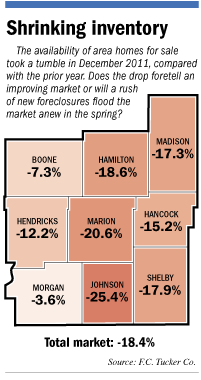Subscriber Benefit
As a subscriber you can listen to articles at work, in the car, or while you work out. Subscribe NowThose shopping for a home this year could encounter an unexpected dilemma: Fewer properties to choose from.
About 12,000 homes were listed for sale at the end of December in the nine-county central Indiana market, a roughly 18-percent drop from a year earlier and a dramatic fall from the 21,000 homes up for sale at the end of 2009, data from F.C. Tucker Co. Inc. shows.
 The market had a nine-month supply of homes under $300,000, compared with a 12-month supply a year earlier. A four- to six-month supply is the point where buyers and sellers stand on equal footing, F.C. Tucker President Jim Litten said.
The market had a nine-month supply of homes under $300,000, compared with a 12-month supply a year earlier. A four- to six-month supply is the point where buyers and sellers stand on equal footing, F.C. Tucker President Jim Litten said.
The implications of a tighter inventory of homes are broad: With fewer homes for sale, there’s more demand for the remaining ones, which can lead to more competition among buyers and higher prices for sellers.
“If you see this market kick up and we don’t get some more houses coming on the market,” Litten said, “we’re going to switch from a buyer’s market to a seller’s market.”
But it won’t happen overnight. Litten expects the number of homes sold this year will rise as much as 10 percent and average sale prices will rise at least 4 percent. The market still isn’t back to full strength, but a full year (2011) without any housing stimulus should have put a strong floor under it.
“Consumer confidence is inching up, rates are still low, and consumers are worn out on this recession,” Litten said. “There are more potential positives on the horizon than we’ve seen in four years.”
The decrease in inventory has a cascading impact that ultimately leaves sellers in a better position to get a good value for their homes than a year ago, said Tracy Hutton, president of the local residential brokerage Century 21 Scheetz.
“Buyers are starting to feel the reduction in inventory because there aren’t as many options out there,” she said. “That’s motivating them to be more aggressive, and average sales prices are rising in some areas.”
In the nine-county region, the average home sale price rose just shy of 1 percent in 2011, to about $152,000. Hamilton and Madison counties led the way, with gains of about 2 percent, while Hendricks and Shelby counties saw average sale prices fall 3 percent.
Hutton expects steady improvement.
“Real estate offices this January have a much better feel than last January,” she said.
These days, finding good homes to list for sale has been tougher than finding willing buyers, a welcome reversal, said Dick Richwine, a residential broker with Prudential Indiana Real Estate Group who regularly ranks among the market’s most productive agents.
“There’s pent-up demand now and we’re seeing some pick-up on the buying side, which is helping eat up some of the excess inventory we’ve had,” Richwine said.
Among the deals Richwine closed in the fourth quarter was the sale of Reggie Miller’s former home on Geist Reservoir. The buyer, a local executive, paid $4.5 million. (The market has a much bigger backlog, more than two years’ supply, of million-dollar-plus homes.)
Richwine sees a variety of encouraging trends, including a shortage of lots for new homes and the fact that some submarkets, including Meridian Kessler, downtown and parts of Carmel, already seem to have stabilized. Buyers are looking around even in the dead of winter.
But there are caveats. Banks have brought foreclosure sales to a trickle, in part to get their paperwork in line. If they reopen the foreclosure floodgates, the market could sink.
There’s also no guarantee interest rates will remain at historic lows. And homeowners still are reluctant to put their homes up for sale, fearing the sale price will fall below what they owe.
“I do think we’re in the process of 2012 being a bottoming-out year, predicated on some things outside our control,” Richwine said.
One of those factors is consumer confidence, which ticked up to 64.5 in December on The Conference Board’s index, the highest level since April 2011.
Litten also is concerned about another rush of foreclosure properties, but he notes that about 30 percent of those properties are purchased by investors who turn the homes into rentals. In other words, the properties don’t make as much of an impact on inventory as you might expect.
And buyers worried about losing money on the home they’re selling can take solace in their potential savings if they buy a more expensive house.•
Please enable JavaScript to view this content.
